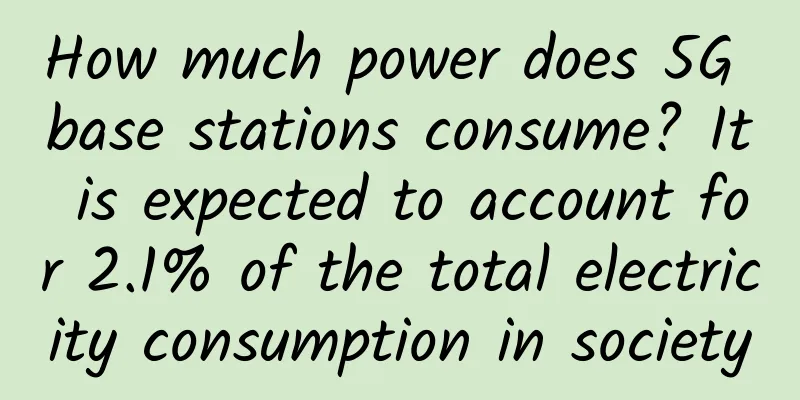How much power does 5G base stations consume? It is expected to account for 2.1% of the total electricity consumption in society

|
As we all know, since the first half of the year, there have been reports that 5G base stations consume too much power and even wealthy operators cannot afford the electricity bills. Because according to data, standard 5G base stations consume about four times more electricity than standard 4G base stations. Considering that 5G base stations have a smaller coverage area and require more base stations, if 6 million 5G base stations are built nationwide, the annual electricity bill of the three major operators will be about 240 billion yuan, more than 200 billion yuan more than in the 4G era. The combined profit of the three major operators in 2019 was only 138 billion yuan, which is not enough to pay the electricity bill.
Of course, regarding the power consumption of 5G base stations, operators have also tried every possible way, such as reducing peak loads and filling valley loads, using AUU technology, and shutting down 5G base stations at night to save power. But it is obvious that these technologies are only a temporary solution. To truly solve the power consumption problem, we have to find a way to reduce the power consumption of 5G base stations themselves. Therefore, everyone is focusing on the advancement of 5G technology. For example, Qualcomm said some time ago that the evolution of 5G standards from Rel-15 to Rel-16 may save about 50% (43-47%) of power. But in fact, to this day, the problem of high power consumption of 5G has not been solved yet. Of course, some people are skeptical about this power consumption, thinking that it is just an attempt by some people to discredit 5G equipment manufacturers. However, recently, at the "2020 Communications Industry Conference and the 15th Communications Technology Annual Conference", some experts formally quantified the power consumption of 5G base stations. Experts said that in 2019, the power consumption of 5G base stations in my country accounted for about 0.05% of the total social electricity consumption. But in the future, as more and more 5G base stations are built, the power consumption of 5G base stations will also increase. By 2023, the power consumption of 5G base stations will account for 1.3% of the total electricity consumption in society. By 2026, the power consumption of 5G base stations will account for 2.1% of the total electricity consumption in society. In 2019, the total electricity consumption in the country was 722.55 billion kWh. It is estimated that by 2026, it will reach about 10 trillion kWh, which means that the power consumption of 5G base stations will reach 210 billion kWh. Based on the industrial electricity consumption of 1 yuan per kilowatt-hour, the annual electricity bill is more than 200 billion yuan. It can be seen that 5G base stations consume a lot of electricity. This is not false, but a fact. But we can also predict that with the advancement of technology, the power consumption of 5G base stations may decrease, but it will definitely be higher than 4G. Therefore, in order to pay the electricity bills, the three major operators will inevitably pass on the costs to consumers. It is unlikely that 5G charges will drop in a short period of time. What do you think? |
Recommend
On the improvement skills of data center operation and maintenance
The stable operation of a data center is insepara...
WIFi 5 Final Madness 2019 Wireless Router Market Report
In 2019, the wireless router market faced the fie...
The original intention of building Huawei Software Development Cloud: to deliver excellent development methods and capabilities to software companies and developers
[51CTO.com original article] With the rapid devel...
The winner of Huawei Ecosystem Partner Elite Competition is finally revealed, and the cloud ecosystem embarks on a new journey
[51CTO.com original article] On October 28, after...
spinservers: 10Gbps high-end San Jose server, $109/month, dual E5 2650Lv3/64GB/1.6T SSD hard drive
spinservers is a site under Majestic Hosting Solu...
Hosteons France/Germany data centers are online, $17.99/year-1GB/20G NVMe/2TB@10Gbps
Hosteons announced the launch of VPS in French (P...
51% of companies said that lack of appropriate technical infrastructure and IT systems is a major challenge to digitalization
According to a survey conducted by the NASDAQ, wi...
Ruijie RG-CT7800 launched online, "Dual Engines on the Cloud" creates a model of innovation in information technology applications
[Ruijie Networks Press Release] On April 10, Ruij...
Top 10 Web Trends: How to Stay Ahead in 2021
[[422976]] 【51CTO.com Quick Translation】 Due to t...
The 17th China Enterprise Annual Selection List for 2022 was announced: Juniper Networks China CTO Jing Youhao won the 2022 IT Industry Network Outstanding Contributor
In November 2022, the "China Enterprise &quo...
Cutover failed, resulting in 3/4/5G network communication failure
[[429420]] A cutover and replacement by Japanese ...
Is blockchain the next big thing? But it can easily fail if you’re not careful
On December 17 last year, according to the Bitcoi...
The Chinese market size of the new “5G+VR” consumption model is expected to reach 90 billion yuan
Wear VR (virtual reality) equipment to travel aro...
[6.18] Megalayer: Hong Kong CN2 independent server from 400 yuan/month, US cluster server from 888 yuan/month
Megalayer's 618 promotion officially started ...
What is missing from licensing 5G for commercial use?
On February 20, South Korea announced the officia...









